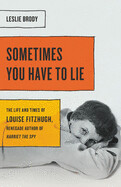Sometimes You Have to Lie
"I've never been more intensely curious about a writer's life, nor more thwarted in finding anything out about that life, than I have been in the case of Louise Fitzhugh. At some point I deduced that the very lack of information likely answered my most burning question--was she a lesbian? But that was little preparation for the true story. What a lesbian! And what a life! Leslie Brody serves up an almost unbearably gratifying tale in her much-anticipated biography, Sometimes You Have To Lie. Southern Gothic childhood. Escape to Greenwich Village and Europe. Famous friends. String of lovers. Cross-dressing. Publishing gossip. Even a lost manuscript. I was especially pleased to learn so much about the painting career of this groundbreaking writer who considered herself just as much a visual artist. I only wish Brody's book, and Fitzhugh's life, had been much, much longer."-- Alison Bechdel, author of Fun Home
In this inspiring biography, discover the true story of Harriet the Spy author Louise Fitzhugh -- and learn about the woman behind one of literature's most beloved heroines.
Harriet the Spy, first published in 1964, has mesmerized generations of readers and launched a million diarists. Its beloved antiheroine, Harriet, is erratic, unsentimental, and endearing -- very much like the woman who created her, Louise Fitzhugh. Born in 1928, Fitzhugh was raised in segregated Memphis, but she soon escaped her cloistered world and headed for New York, where her expanded milieu stretched from the lesbian bars of Greenwich Village to the art world of postwar Europe, and her circle of friends included members of the avant-garde like Maurice Sendak and Lorraine Hansberry. Fitzhugh's novels, written in an era of political defiance, are full of resistance: to authority, to conformity, and even -- radically, for a children's author -- to make-believe. As a children's author and a lesbian, Fitzhugh was often pressured to disguise her true nature. Sometimes You Have to Lie tells the story of her hidden life and of the creation of her masterpiece, which remains long after her death as a testament to the complicated relationship between truth, secrecy, and individualism.
